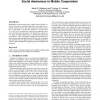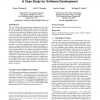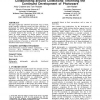CSCW
2004
ACM
14 years 5 months ago
2004
ACM
Under-contribution is a problem for many online communities. Social psychology theories of social loafing and goal-setting can provide mid-level design principles to address this ...
CSCW
2004
ACM
14 years 5 months ago
2004
ACM
Computer system administrators are the unsung heroes of the information age, working behind the scenes to configure, maintain, and troubleshoot the computer infrastructure that un...
CSCW
2004
ACM
14 years 5 months ago
2004
ACM
Maintaining social awareness of the working context of fellow coworkers is crucial to successful cooperation. For mobile, non colocated workers, however, this social awareness is ...
CSCW
2004
ACM
14 years 5 months ago
2004
ACM
During face-to-face interactions, groups frequently overly rely on the dominant viewpoint to lead the group in its decision-making process. We begin with a discussion of this phen...
CSCW
2004
ACM
14 years 5 months ago
2004
ACM
The growing use of Instant Messaging for social and work-related communication has created a situation where incoming messages often become a distraction to users while they are p...
CSCW
2004
ACM
14 years 5 months ago
2004
ACM
Spontaneous communication is common in the workplace but can be disruptive. Such communication usually benefits the initiator more than the target of an interruption. Previous res...
CSCW
2004
ACM
14 years 5 months ago
2004
ACM
The lack of lightweight communication channels and other technical and sociological difficulties make it hard for new members of a non-collocated software development team to lea...
CSCW
2004
ACM
14 years 5 months ago
2004
ACM
This paper explores the embodied interactional ways in which people naturally collaborate around and share collections of photographs. We employ ethnographic studies of paper-base...
HUMAN
2005
Springer
14 years 5 months ago
2005
Springer
Internet-based collaboration opens a vast stream of opportunities for developing countries in acquiring international assistance. In this paper, we identify technology transferring...
HUMAN
2005
Springer
14 years 5 months ago
2005
Springer
Abstract. A groupware that integrates synchronous and asynchronous collaboration paradigms is developed to support international medical collaboration activities carried out among ...




